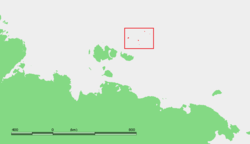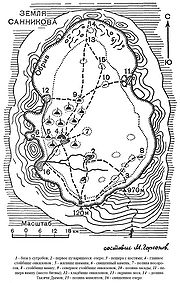
Sannikov Land
Encyclopedia

Phantom island
Phantom islands are islands that were believed to exist, and appeared on maps for a period of time during recorded history, but were later removed after they were proved to be nonexistent...
in the Arctic Ocean
Arctic Ocean
The Arctic Ocean, located in the Northern Hemisphere and mostly in the Arctic north polar region, is the smallest and shallowest of the world's five major oceanic divisions...
. Its supposed existence became something of a myth in 19th-century Russia
Russia
Russia or , officially known as both Russia and the Russian Federation , is a country in northern Eurasia. It is a federal semi-presidential republic, comprising 83 federal subjects...
.
Yakov Sannikov
Yakov Sannikov
Yakov Sannikov was a Russian merchant and explorer of the New Siberian Islands.In 1800, Sannikov discovered and charted Stolbovoy Island, and in 1805 Faddeyevsky Island. In 1809-1810, he took part in the expedition led by Matvei Gedenschtrom. In 1810, Sannikov crossed the island of New Siberia...
and Matvei Gedenschtrom
Matvei Gedenschtrom
Matvei Matveyevich Gedenschtrom was a Russian explorer of Northern Siberia, writer, and public servant.Matvei Gedenschtrom attended University of Tartu. He did not finish his studies and left his alma mater in favor of work at Tallinn customs. Soon, however, he was arrested in connection with a...
claimed to have seen it during their 1809-1810 cartographic expedition to the New Siberian Islands
New Siberian Islands
The New Siberian Islands are an archipelago, located to the North of the East Siberian coast between the Laptev Sea and the East Siberian Sea north of the Sakha Republic....
. Yakov Sannikov was the first one to report the sighting of a "new land" north of Kotelny Island in 1811 (hence, the name "Sannikov Land").
In 1886, a Baltic German
Baltic German
The Baltic Germans were mostly ethnically German inhabitants of the eastern shore of the Baltic Sea, which today form the countries of Estonia and Latvia. The Baltic German population never made up more than 10% of the total. They formed the social, commercial, political and cultural élite in...
explorer in Russian service, Eduard Toll
Eduard Toll
Eduard Gustav von Toll was a Baltic German geologist and Arctic explorer in Russian service. Often referred to as Baron von Toll or as Eduard v. Toll, in Russia he is known as Eduard Vasiliyevich Toll . Eduard Toll was born on and he died in 1902 in an unknown location in the Arctic Ocean)...
, reported observing the elusive land during an expedition to the New Siberian Islands. In August 1901, during another expedition led by Toll, The Russian Polar Expedition, Russian Arctic ship Zarya
Zarya (polar ship)
Zarya was a steam- and sail-powered brig used by the Russian Academy of Sciences for a polar exploration during 1900–1903.Toward the end of the 19th century, the Russian Academy of Sciences sought to build a general-purpose research vessel for long-term expeditions. The first such Russian...
headed across the Laptev Sea
Laptev Sea
The Laptev Sea is a marginal sea of the Arctic Ocean. It is located between the northern coast of Siberia, the Taimyr Peninsula, Severnaya Zemlya and the New Siberian Islands. Its northern boundary passes from the Arctic Cape to a point with co-ordinates of 79°N and 139°E, and ends at the Anisiy...
, searching for the legendary Sannikov Land (Zemlya Sannikova) but was soon blocked by floating pack ice in the New Siberian Islands
New Siberian Islands
The New Siberian Islands are an archipelago, located to the North of the East Siberian coast between the Laptev Sea and the East Siberian Sea north of the Sakha Republic....
. During 1902 the attempts to reach Sannikov Land, deemed to be beyond the De Long Islands
De Long Islands
The De Long Islands are an uninhabited archipelago often included as part of the New Siberian Islands, lying north east of Novaya Sibir. This archipelago consists of Jeannette Island, Henrietta Island, Bennett Island, Vilkitsky Island and Zhokhov Island. These five islands have a total area of...
, continued while Zarya was trapped in fast ice. Leaving the ship, Russian Arctic explorer Baron Eduard Toll and three companions vanished forever in November 1902 while travelling away from Bennett Island
Bennett Island
Bennett Island is the largest of the islands of the De Long group in the northern part of the East Siberian Sea. The area of this island is approximately 150 km² ...
towards the south on loose ice floes.
A search by the Soviet icebreaker Sadko
Icebreaker Sadko
Icebreaker Sadko was a Russian and Soviet icebreaker ship of 3,800 tonnes displacement. She was named after Sadko, a hero of a Russian bylina....
was announced in 1936 and carried out in 1937 but found no trace of the land.
Despite the intensified search, it was established finally during the first half of the 20th century that the Sannikov Land no longer exists.
Some historians and geographers, judging from other successes of Sannikov and the presence of shallow sand shoals at its mapped location, postulate that Sannikov Land indeed existed, but was destroyed by coastal erosion and became a submerged sand shoal like many other islands, formed either of fossilized ice
Ice
Ice is water frozen into the solid state. Usually ice is the phase known as ice Ih, which is the most abundant of the varying solid phases on the Earth's surface. It can appear transparent or opaque bluish-white color, depending on the presence of impurities or air inclusions...
or of permafrost
Permafrost
In geology, permafrost, cryotic soil or permafrost soil is soil at or below the freezing point of water for two or more years. Ice is not always present, as may be in the case of nonporous bedrock, but it frequently occurs and it may be in amounts exceeding the potential hydraulic saturation of...
. This process of disappearing of Arctic islands continues within the New Siberian Islands
New Siberian Islands
The New Siberian Islands are an archipelago, located to the North of the East Siberian coast between the Laptev Sea and the East Siberian Sea north of the Sakha Republic....
archipelago
Archipelago
An archipelago , sometimes called an island group, is a chain or cluster of islands. The word archipelago is derived from the Greek ἄρχι- – arkhi- and πέλαγος – pélagos through the Italian arcipelago...
. Other historians and geographers hypothesize that Sannikov Land might have been a miraged image, which occur frequently in the Arctic region, of Bennett Island
Bennett Island
Bennett Island is the largest of the islands of the De Long group in the northern part of the East Siberian Sea. The area of this island is approximately 150 km² ...
. Another group of scholars regard Sannikov Land as a form of pseudohistory
Pseudohistory
Pseudohistory is a pejorative term applied to a type of historical revisionism, often involving sensational claims whose acceptance would require rewriting a significant amount of commonly accepted history, and based on methods that depart from standard historiographical conventions.Cryptohistory...
.
Cultural appearances

Geologist
A geologist is a scientist who studies the solid and liquid matter that constitutes the Earth as well as the processes and history that has shaped it. Geologists usually engage in studying geology. Geologists, studying more of an applied science than a theoretical one, must approach Geology using...
and science fiction
Science fiction
Science fiction is a genre of fiction dealing with imaginary but more or less plausible content such as future settings, futuristic science and technology, space travel, aliens, and paranormal abilities...
writer Vladimir Obruchev
Vladimir Obruchev
Vladimir Afanasyevich Obruchev was a Russian and Soviet geologist who specialized in the study of Siberia and Central Asia. He was also one of the first Russian science fiction authors.- Scientific research :...
fictionalized this phantom island in his novel Sannikov Land (1926). In the story, the island provided the last escape for a tribe of Onkilon (in fact, this was one of the older names for Yuit
Siberian Yupik
Siberian Yupiks, or Yuits, are indigenous people who reside along the coast of the Chukchi Peninsula in the far northeast of the Russian Federation and on St. Lawrence Island in Alaska. They speak Central Siberian Yupik , a Yupik language of the Eskimo–Aleut family of languages.They were also...
), pushed away from the mainland by other Siberia
Siberia
Siberia is an extensive region constituting almost all of Northern Asia. Comprising the central and eastern portion of the Russian Federation, it was part of the Soviet Union from its beginning, as its predecessor states, the Tsardom of Russia and the Russian Empire, conquered it during the 16th...
n peoples. The (fictional) Onkilon were thought to be extinct, and were discovered by a small expedition looking for the island and eventually stranded at it.
Obruchev, inspired by Arthur Conan Doyle
Arthur Conan Doyle
Sir Arthur Ignatius Conan Doyle DL was a Scottish physician and writer, most noted for his stories about the detective Sherlock Holmes, generally considered a milestone in the field of crime fiction, and for the adventures of Professor Challenger...
's The Lost World
The Lost World (Arthur Conan Doyle)
The Lost World is a novel released in 1912 by Sir Arthur Conan Doyle concerning an expedition to a plateau in the Amazon basin of South America where prehistoric animals still survive. It was originally published serially in the popular Strand Magazine during the months of April 1912-November 1912...
, provided a reasonable justification of the possibility of the described things and events. The island turned out to be a crater of a volcano and a warm place, heated by the volcano. It also hosted a tribe of Neanderthals (called "Vampoo") and mammoths. In the end of the story the volcano erupts and destroys the land.
In 1973, a science fiction movie called Sannikov Land was released in the Soviet Union
Soviet Union
The Soviet Union , officially the Union of Soviet Socialist Republics , was a constitutionally socialist state that existed in Eurasia between 1922 and 1991....
.
See also
- 1906 German map showing Sannikov Land north of Kessel (Kotelny) Island
- Crocker LandCrocker LandCrocker Land was the name Robert Peary gave to a mass of land which he believed he saw in the distant northwest from the summit of Cape Thomas Hubbard, during a 1906 expedition. Peary estimated the landmass to be 130 miles away at about 83 degrees N, longitude 100 degrees W...
- Bradley LandBradley LandBradley Land was the name Frederick Cook gave to a mass of land which he claimed to have seen between and during a 1909 expedition. He described it as two masses of land with a break, a strait, or an indentation between. The land was named for John R...

